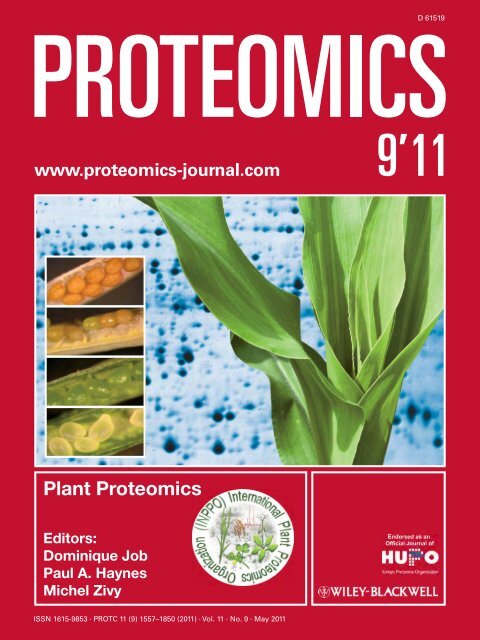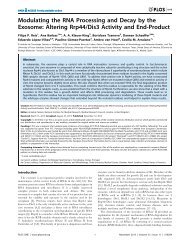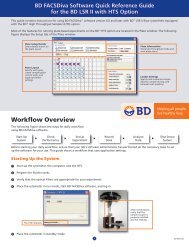Cover Picture: Proteomics 9'11
Cover Picture: Proteomics 9'11
Cover Picture: Proteomics 9'11
- No tags were found...
You also want an ePaper? Increase the reach of your titles
YUMPU automatically turns print PDFs into web optimized ePapers that Google loves.
<strong>Proteomics</strong> 2011, 11, 1559–1568 1561the environment, promoting sustainable agriculture andpreserving biodiversity.2 <strong>Proteomics</strong><strong>Proteomics</strong> is one of the potent approaches developed in theera of ‘omics,’ complementing and linking transcriptomicsand metabolomics. In this context, proteomics offers uniqueinsight into the cellular function at the level of cell, organelles,tissues, organs and whole organisms [42]. Figure 1highlights where we are on the plant proteomics front, withmodel species including Arabidopsis [43–46] and rice [24, 47]paving the way for emerging model and non-model plants tobe involved in proteomics research (for further reading on thesubject, readers are referred to [8, 48, 49]). We must recognizethe fact that plant proteomics lags behind yeast and humanproteomics as shown by a search of the number of publicationsin these disciplines from the ISI Web of Science(May 2010). Yet the impact of human proteomics is proportionallysmaller than that of plant proteomics. This is simplybecause laboratories around the world have shown a greatinterest in embracing proteomics at a global scale to addresstheir biological question(s) in plants [8, 48, 50–55]. The graphpresented in Fig. 2 reveals the extent of development in plantproteome research with more than 300 papers in 2009, afterthe publication of the first plant proteomics paper in 1999,using the single term plant proteom to search the PubMeddatabase (www.pubmed.com). Plant proteomics statisticsclearly reveals progress in unraveling the proteomes, particularlyof Arabidopsis, rice and maize, and other emergingmodel plants and crops, as well as progress in techniques andbioinformatics for plant proteomics analysis. It is worthmentioning that the proteomics subcommittee of the MultinationalArabidopsis Steering Committee (MASC; http://www.masc-proteomics.org/) has been established to assist inthe coordination of research in Arabidopsis in the area ofproteomics. The participating research groups assembledmost of the available proteomics databases to the largestproteomics resource for a single model plant A. thaliana [11].Thus, this platform could be seen as a template how totranslate proteomics technologies such as 2-DE, genome-widetargeted proteomics or ‘Mass Western’ [56, 57], screeningmethods like shotgun proteomics in abiotic and biotic stressand mass spectrometric analysis of tissue and subcellularprotein localization [33, 54, 58] to other plant model systems.<strong>Proteomics</strong>, like other ‘omics,’ also refers to the parallelanalysis of numerous molecules. Current proteomic toolshave dramatically improved over the last decade, mostly dueto the rapid and significant improvement in the sensitivity,throughput and mass accuracy of modern mass spectrometers.However, the coverage of proteomes is still not ascomprehensive as transcriptomes. This high number ofparallel analyses can be, and has been, exploited withdifferent aims. On the one hand, proteomics has become atool of annotation of individual proteins, by supplyinginformation that is complementary to genomic and transcriptomicsinformation such as: identification of themethionine of translation initiation; intron/exon boundaries;splicing variants; experimental proof of protein accumulationin different organ or tissues or in response tovarious stimuli; subcellular location; the presence andnature of post-translational modifications (PTMs); [59–62];and association with other proteins in functional complexes[63–65]. These additional data provide information that canbe exploited in databases where genomic and proteomicsdata are gathered (e.g. PPDB at http://ppdb.tc.cornell.edu/[66]; AtProteome at http://fgcz-atproteome.unizh.ch/ [9];PROMEX at http://promex.pph.univie.ac.at/promex/ [11];PhosPhAt at http://phosphat.mpimp-golm.mpg.de/ [67]).On the other hand, other proteomics studies do not aim atcharacterizing the proteins themselves but rather to understandthe cellular responses to a given biological phenomenon,such as response to environmental changes, ordevelopmental and phenotypic variations, by identificationand quantification of the proteins involved. The interpretationof these types of studies are integrative and necessitatethe use of databases that link genes and proteins toFigure 2. Growth index of plantproteomics. The literature survey(May 2010) was carried out usingthe key word plant proteom and the search engine PubMed.& 2011 WILEY-VCH Verlag GmbH & Co. KGaA, Weinheimwww.proteomics-journal.com
1562 G. K. Agrawal et al. <strong>Proteomics</strong> 2011, 11, 1559–1568functions and pathways (e.g. databases based on Geneontologies, MAPMAN and PPDB) [68–70], and wouldbenefit from links with transcriptome and metabolome data.It is worthwhile noting that proteomics can be instrumentalin linking quantitative genetics and physiology, in particularby mapping PQLs (protein QTLs (quantitative trait loci),[71–73]). While eQTLs (expression QTLs) have been detectedby using transcriptome microarrays, the link with metabolismis relatively loose, partly because of PTMs, includingthose involved in protein turn over. Metabolomics profilingprovides very interesting phenotypic data and metaboliteQTLs can be mapped [74]. The integration of metabolomicswith transcriptomics and proteomics is another innovativeway to assign gene functions within a genome and analyzeplant responses at a systems level [33, 75].As proteins are the final products of genes, they potentiallyaccount better than transcripts for activity variationssimply because: (i) their accumulation level is the result of acombination of transcription, translation and protein turnover,and (ii) proteomics studies can also analyze PTMs thatmodulate their activity. All causes of these variations canpotentially be studied, from genes regulating transcriptionto enzymes responsible for PTMs. PTMs affect enzymeactivity and subcellular localization, participate in signaling(e.g. phosphorylation) and play important roles in thematuration of storage proteins. Most of these phenomenacannot be predicted from genome or transcriptome data. Afeature of most plants living in temperate climates is theirreliance on dehydrated stages including seeds [76] andpollen grains [77, 78], where the regulation of mRNA andprotein abundances are particularly disconnected and wherePTMs play an important role.The throughput of proteomics studies is still lower thanthat of transcriptomics studies regarding the number ofgenes and proteins analyzed. The number of proteins thatcan be identified and quantified in a single shotgun MS/MSbasedproteomics experiment using current technology istypically from 500 to several thousands at maximum. Incontrast, tens of thousands of predicted transcripts of anorganism can be analyzed in one experiment (microarrays,SAGE or new generation RNA sequencing), includingquantification of transcript expression levels. However,because cellular reactions directly depend on their amountand state, the analysis of protein variation is potentiallymore informative than the analysis of transcript abundancesfor the analysis of the determinism of quantitative traits.Experimental designs for this type of analysis comprisenumerous genotypes (e.g. populations of recombinantinbred lines). Although up to 200–300 2-D gels can inprinciple be analyzed in the same experiment (e.g. [71, 79]),this is not practical for most laboratories due to the highcosts of materials and labor, and complex tracking andimage analysis. Advances in MS [2], and particularly in labelfreequantification, have made possible the analysis of verylarge data sets in complex multi-variate experimentaldesigns [33, 80]. These approaches will allow the detection ofprotein QTLs and the quantification of candidate proteins inlarge panels for association genetics, enabling new ‘associationproteomics’ programs in plants. Last but not least,continuous progress in sub-cellular identification of proteinsallows pushing the limits toward a detailed understandingof plant proteomes at the sub-organelle, organelle, cell,tissue and organ levels [58, 81].3 The rationale and birth of InternationalPlant <strong>Proteomics</strong> Organization (INPPO)Nevertheless, there is something lacking in our questtoward the ambitious goal of achieving complete understandingof proteomes of plant species. There are manyreasons that can be proposed to explain this gap in ourknowledge. To suggest a few, there is lack of access toproteomics in most plant laboratories around the world, lackof information, lack of close cooperation among proteomicsresearchers and most importantly lack of a suitable platformto globally discuss plant proteomics from both fundamentaland applied perspectives. In addition, there is a morepressing concern that remains to be addressed, which is theincredibly large diversity of plants and crops on our planet,which means different things to different people andsocieties.Only a very few plants are the subject of intensiveresearch efforts, the vast majority are not. For example,Arabidopsis [82, 83] is studied as a model plant largelybecause it was the first plant to be sequenced, has wellestablishedgene manipulation techniques [84], a quick lifecycle and is very easy to handle. Rice, on the other hand, hasa relatively long life cycle, and is difficult to handle, but isbeing investigated as a model for cereal monocot crops(such as wheat, rye, barley and maize), largely because it isthe primary food source of half the world’s population.Oilseeds, other than providing a rich source of energy in ourfood, are being economically exploited as bio-fuel producers.The same holds true for sugarcane and sugarbeet for thesugar they provide us, grapes for wine production andcotton in textile industries. Poplar has been used as themodel plant for woody species [85], for economic and ecophysiologicalreasons, as e.g. it has a wide distribution in thenorthern hemisphere, and hence can be transformed andeasily in vitro propagated. The poplar model has been usedin many studies to provide data on the effects of environmentalstressors in woody plans, and to investigate featuresspecific to woody species, i.e. formation of secondary tissues,overwintering, etc. [86]. Figure 3 highlights some of themajor plants/crops in the world along with their geographicaldistribution. Looking globally, one thing stands out –‘global impact of global plant proteomics.’ In other words,the importance of proteomics in the biological context, plantdiversity and the essential contribution of that biodiversity tothe socio-economic fabric of humankind is beyond anydoubt. Although we would like to claim that proteomics of& 2011 WILEY-VCH Verlag GmbH & Co. KGaA, Weinheimwww.proteomics-journal.com
1564 G. K. Agrawal et al. <strong>Proteomics</strong> 2011, 11, 1559–1568Model plantsProteomewww.inppo.comArabidopsisRiceSolanaceaeCerealsINPPOCropsLegumesSystemsFigure 4. The INPPO initiative. INPPO isproposed to be initially based on three pillarsof database organization, annotation anddissemination along with other initiatives asdetailed in the text for better plant, seedquality and plant/crop yields.5 The INPPO initiativesThe INPPO initiative will be to:(i) Further intensify successful ongoing cooperation in the fieldof plant proteomics for both model and crop plants: Thiswill involve collaborative research with fellow plantproteome researchers at both national and internationallevels. It is emphasized that with the availabilityof genomes of many plants, which will keep increasing,people will be motivated to make a move towardglobal plant proteomics.(ii) Promote the establishment of national plant proteomicsorganizations: To encourage proteomics research ineach and every country as far as possible, with moreemphasis in developing countries. In this way moreand more people will be interested to know aboutplant proteomics and its benefit. An example of thatis the French Green Proteome Network, which iswilling to support or defend the launching ofproteomics projects under the banner of INPPO,both at the national and European levels. At theEuropean level, the COST program ‘Plant <strong>Proteomics</strong>in Europe’ is also a good example of a structureallowing fruitful exchanges (http://www.costfa0603.org/).At the multinational level, the workinggroup (of proteomics subcommittee of MASC;http://www.masc-proteomics.org/) devoted to Arabidopsisproteomics aims to combine the efforts ofdifferent research groups to develop programs thatwill consolidate databases, technique standards andexperimentally validated candidate genes and functions.(iii) Develop an open partnership around the globe: A fruitfuloutcome of the organization will be in the gains madeby individual researchers around the world by havingopen presentations and discussions aimed at not onlyimproving their own proteomics research but gaininginformation, expertise and skills therein. In addition,partnerships with other organizations, such aspublishing groups and news channels, are to beencouraged. For example, authors can follow thejournal guidelines and find information where tosubmit proteomics and/or large-scale MS data setsusing well-defined criteria. The HUPO <strong>Proteomics</strong>Standards Initiative (PSI) defines community standardsfor data representation in proteomics to facilitatedata comparison, exchange and verification. ThePRIDE (PRoteomics IDEntifications database; http://www.ebi.ac.uk/pride/) is a centralized, standardscompliant, public data repository for proteomics data.(iv) Bridge the gap between academy and industry: Mutuallybeneficial efforts to mine the proteomes of differentplant species, economic or otherwise, will provideimmense benefits to the industry and incentives toacademia to keep working on plants.(v) Establish centralized databases at several locations (Americas,Europe, Asia-Pacific and Australia) with their realtimeintegration: Initiate an easily accessible andreadable interlinked database for 2-D gel referencemaps, large-scale protein qualitative and quantitativedata sets for species, organs and organelles, as well asprotein–protein interactions and PTMs. These databaseswill be continuously updated and maintainedwhere deposited data will be effectively organized,annotated and disseminated. It is emphasized that& 2011 WILEY-VCH Verlag GmbH & Co. KGaA, Weinheimwww.proteomics-journal.com
<strong>Proteomics</strong> 2011, 11, 1559–1568 1565once these centers are up and running, efforts willbe made to include Africa and Middle-Easternregions into the fold. Further extension will dependon their necessity. Provide and distribute a newsletterand published articles to each and everymember of INPPO and also to those interested nonmembersto keep them abreast of the latest developmentsin plant proteomics, because with knowledgecomes the option of doing something fruitful, andevery student, post-doc or researcher, can contributesomething.(vi) Organize workshops at national and international levelsto train manpower and exchange information: Thiswill be a global venue for plant proteome researchersto present, hear and discuss their individual plantsand their proteomes. We will need support fromuniversities, industries and governments at thisfounding stage to help with training a new generationof young scientists, especially from developing countriesin pursuing professional careers in plantproteomics.(vii) Integrate proteomics-related activities and disseminatethem to partners through the INPPO website: As theinformation is the key of success, one such activity thisinitiative will involve is to enrich the scientificcommunity by providing access to information andpublished articles in the field of plant proteomics. Thiswill lead to an acceleration in plant proteomicsresearch.(viii) Bring proteomics to every laboratory working on plantsaround the globe: This is critical as each country andlaboratory has something to give. For example,developing countries may lag behind in facilities toconduct research on a global scale, but they may beable to help with talented manpower in bioinformaticsand computer science to help speed up the process ofhandling, analyzing and extracting biologically meaningfuldata.(ix) Aim to outreach to the younger generation students at theschool, college and university levels: Engagement ofstudents is essential in order to assure the future ofplants and their proteomes, and with them, our planet.(x) Help translate the proteomics knowledge into biology andvice versa: Think ‘out of the box.’On the way to achieving these initiatives, INPPO willactively work to be self-sustainable. To do so, and achieveour common goals, we need all interested parties tojoin us at INPPO (Fig. 5) in this endeavor. Nothing isimpossible, if we work together, and history is evidence forthat.6 Addressing INPPO – An outlineThe initiatives discussed will be addressed in multiplephases. The initial phase of INPPO will be to:(i) Circulate this message through websites (includingINPPO and plant/proteomics-related journals) to allpeople (researchers and students) involved in proteomicsin plants, globally. At this step the importance ofINPPO, its goals and initiatives will be introduced anddiscussed, in order to get feedback (ideas/reactions/comments via INPPO website). This will lead torecruitment of members of INPPO in all areas.(ii) Install at least two representatives from each participatingcountry.(iii) Launch INPPO.(iv) Organize a meeting of the founding members tofurther discuss and chalk out the next phases ofINPPO, such as to organize an international meetingon INPPO with the initiators, founding members,representative and supporting members from aroundthe globe for discussing a governing body, initiatives,and most importantly funding from governments andprivate sectors.Figure 5. Join us at INPPO (http://www.inppo.com). Each piece ofthe puzzle represents a major plant/crop proteome in eachcontinent/region/country. INPPO will function globally to linkthem together.Authors appreciate the help of Ms. Junko Shibato (NationalInstitute of Environmental Studies, NIES, Tsukuba, Japan) indesigning the logo of INPPO and Raj Agrawal (Computerengineer and programmer) in designing and taking care of theINPPO website. R. R. also acknowledges the great support ofProfessors Seiji Shioda (Department of Anatomy I, School ofMedicine, Showa University) and Yoshinori Masuo (Departmentof Biology, Faculty of Science, Toho University) inpromoting inter-disciplinary research and unselfish encouragement.The authors have declared no conflict of interest.& 2011 WILEY-VCH Verlag GmbH & Co. KGaA, Weinheimwww.proteomics-journal.com
1566 G. K. Agrawal et al. <strong>Proteomics</strong> 2011, 11, 1559–15687 References[1] Wilkins, M. R., Sanchez, J. C., Gooley, A. A., Appel, R. D.et al., Progress with proteome projects: why all proteinsexpressed by a genome should be identified andhow to do it. Biotechnol. Genet. Eng. Rev. 1995, 13,S19–S50.[2] Aebersold, R., Mann, M., Mass spectrometry-basedproteomics. Nature 2003, 422, 198–207.[3] Dunkley, T. P., Watson, R., Griffin, J. L., Dupree, P., Lilley,K. S., Localization of organelle proteins by isotope tagging(LOPIT). Mol. Cell. <strong>Proteomics</strong> 2004, 3, 1128–1134.[4] Mikesh, L. M., Ueberheide, B., Chi, A., Coon, J. J. et al., Theutility of ETD mass spectrometry in proteomic analysis.Biochim. Biophys. Acta 2006, 1764, 1811–1822.[5] Cox, J., Mann, M., Is proteomics the new genomics? Cell2007, 130, 395–398.[6] Haynes, P. A., Roberts, T. H., Subcellular shotgun proteomicsin plants: looking beyond the usual suspects. <strong>Proteomics</strong>2007, 7, 2963–2975.[7] Wolff, S., Antelmann, H., Albrecht, D., Becher, D. et al.,Towards the entire proteome of the model bacteriumBacillus subtilus by gel-based and gel-free approaches.J. Chromatogr. B Analyt. Technol. Biomed. Life Sci. 2007,849, 129–140.[8] Agrawal, G. K., Rakwal, R., in: Agrawal, G. K., Rakwal, R.(Eds.), Plant <strong>Proteomics</strong>: Technologies, Strategies, andApplications, Wiley & Sons, Hoboken, NJ 2008.[9] Baerenfaller, K., Grossmann, J., Grobei, M. A., Hull, R. et al.,Genome-scale proteomics reveals Arabidopsis thalianagene models and proteome dynamics. Science 2008, 320,938–941.[10] Bradshaw, R. A., An introduction to proteomics: applicationsto plant biology, in: Agrawal, G. K., Rakwal, R. (Eds.),Plant <strong>Proteomics</strong>: Technologies, Strategies, and Applications,Wiley & Sons, Hoboken, NJ 2008, pp 1–6.[11] Weckwerth, W., Baginsky, S., van Wijk, K. J., Heazlewood,J. L., Millar, H., The multinational Arabidopsis steeringsubcommittee for proteomics assembles the largestproteome database resource for plant systems biology.J. Proteome Res. 2008, 7, 4209–4210.[12] Gianazza, E., Righetti, P. G., Immobilized pH gradients.Electrophoresis 2009, 30, S112–S121.[13] Gorg, A., Drews, O., Luck, C., Weiland, F., Weiss, W., 2-DEwith IPGs. Electrophoresis 2009, 30, S122–S132.[14] Guex, N., Peitsch, M. C., Schwede, T., Automatedcomparative protein structure modeling with SWISS-MODEL and Swiss-PdbViewer: a historical perspective.Electrophoresis 2009, 30, S162–S173.[15] Klose, J., From 2-D electrophoresis to proteomics. Electrophoresis2009, 30, S142–S149.[16] Majeran, W., van Wijk, K. J., Cell-type-specific differentiationof chloroplasts in C4 plants. Trends Plant Sci. 2009, 14,100–109.[17] Rabilloud, T., Membrane proteins and proteomics: love ispossible, but so difficult. Electrophoresis 2009, 30, S174–S180.[18] Wilkins, M. R., Hares and tortoises: the high- versuslow-throughput proteomic race. Electrophoresis 2009, 30,S150–S155.[19] Yates, J. R., 3rd, Ruse, C. I., Nakorchevsky, A., <strong>Proteomics</strong>by mass spectrometry: approaches, advances, and applications.Annu. Rev. Biomed. Eng. 2009, 11, 49–79.[20] Rothstein, S. J., Returning to our roots: making plant biologyresearch relevant to future challenges in agriculture.Plant Cell 2007, 19, 2695–2699.[21] The Arabidopsis Genome Initiative. Analysis of the genomesequence of the flowering plant Arabidopsis thaliana.Nature 2000, 408, 796–815.[22] Goff, S. A., Ricke, D., Lan, T. H., Presting, G. et al., A draftsequence of the rice genome (Oryza sativa L. ssp. japonica).Science 2002, 296, 92–100.[23] Yu, J., Hu, S., Wang, J., Wong, G. K. et al., A draft sequenceof the rice genome (Oryza sativa L. ssp. indica). Science2002, 296, 79–92.[24] International Rice Genome Sequencing Project. The mapbased sequence of the rice genome. Nature 2005, 436,793–800.[25] Tuskan, G. A., DiFazio, S., Jansson, S., Bohlmann, J. et al.,The genome of black cottonwood, Populus trichocarpa(Torr. & Gray). Science 2006, 313, 1596–1604.[26] Lu, C., Wallis, J. G., Browse, J., An analysis of expressedsequence tags of developing castor endosperm usinga full-length cDNA library. BMC Plant Biol. 2007,7, 42.[27] Bedell, J. A., Budiman, M. A., Nunberg, A., Citek, R. W. et al.,Sorghum genome sequencing by methylation filtration.PLoS Biol. 2005, 3, e13.[28] Jaillon, O., Aury, J. M., Noel, B., Policriti, A. et al., Thegrapevine genome sequence suggests ancestral hexaploidizationin major angiosperm phyla. Nature 2007, 449,463–467.[29] Schmutz, J., Cannon, S. B., Schlueter, J., Ma, J. et al.,Genome sequence of the palaeopolyploid soybean. Nature2010, 463, 178–183.[30] Schnable, P. S., Ware, D., Fulton, R. S., Stein, J. C. et al., TheB73 maize genome: complexity, diversity, and dynamics.Science 2009, 326, 1112–1115.[31] Ward, D. C., White, D. C., The new ’omics era. Curr. Opin.Biotechnol. 2002, 13, 11–13.[32] Hennig, L., Patterns of beauty – omics meets plant development.Trends Plant Sci. 2007, 12, 287–293.[33] Wienkoop, S., Morgenthal, K., Wolschin, F., Scholz, M.et al., Integration of metabolomic and proteomic phenotypes:analysis of data covariance dissects starch and RFOmetabolism from low and high temperature compensationresponse in Arabidopsis thaliana. Mol. Cell. <strong>Proteomics</strong>2008, 7, 1725–1736.[34] Megason, S. G., Fraser, S. E., Imaging in systems biology.Cell 2007, 130, 784–795.[35] Long, T. A., Brady, S. M., Benfey, P. N., Systems approachesto identifying gene regulatory networks in plants. Annu.Rev. Cell Dev. Biol. 2008, 24, 81–103.& 2011 WILEY-VCH Verlag GmbH & Co. KGaA, Weinheimwww.proteomics-journal.com
<strong>Proteomics</strong> 2011, 11, 1559–1568 1567[36] Souchelnytskyi, S., 2008. <strong>Proteomics</strong> in the context ofsystems biology, in: Agrawal, G. K., Rakwal, R. (Eds.), Plant<strong>Proteomics</strong>: Technologies, Strategies, and Applications,Wiley & Sons, Hoboken, NJ 2008, pp. 695–709.[37] Coruzzi, G. M., Rodrigo, A., Guttierrez, R. A., 2009. Plantsystems biology, in: Coruzzi, G. M., Rodrigo, A., Guttierrez,R. A. (Eds.), Annual Plant Reviews, Vol. 35, Wiley-Blackwell,Oxford, UK 2009.[38] Yin, X., Struik, P. C., Modelling the crop: from systemdynamics to systems biology. J. Exp. Bot. 2010, 61,2171–2183.[39] Trewavas, A., Aspects of plant intelligence. Ann. Bot. 2003,92, 1–20.[40] Trewavas, A., Plant intelligence. Naturwissenschaften 2005,92, 401–413.[41] Neilson, K. A., Gammulla, C. G., Mirzaei, M., Imin, N.,Haynes, P. A., Proteomic analysis of temperature stress inplants. <strong>Proteomics</strong> 2010, 10, 828–845.[42] Bradshaw, R. A., Burlingame, A., From proteins to proteomics.IUBMB Life 2005, 57, 267–272.[43] Bevan, M., Walsh, S., The Arabidopsis genome: afoundation for plant research. Genome Res. 2005, 15,1632–1642.[44] Bourguignon, J., Jaquinod, M., An overview of theArabidopsis proteome, in: Agrawal, G. K., Rakwal, R.(Eds.), Plant <strong>Proteomics</strong>: Technologies, Strategies,and Applications, Wiley & Sons, Hoboken, NJ 2008,pp. 143–161.[45] Jones, A. M., Chory, J., Dangl, J. L., Estelle, M. et al., Theimpact of Arabidopsis on human health: diversifying ourportfolio. Cell 2008, 133, 939–943.[46] Van Norman, J. M., Benfey, P. N., Arabidopsis thaliana as amodel organism in systems biology. Wiley Interdiscip. Rev.Syst. Biol. Med. 2009, 1, 372–379.[47] Agrawal, G. K., Rakwal, R., Rice proteomics: a cornerstonefor cereal food crop proteomes. Mass Spectrom. Rev. 2006,25, 1–53.[48] Thiellement, H., Zivy, M., Damerval, C., Mechin, V., Plant<strong>Proteomics</strong>: Methods and Protocols, in: Thiellement, H.,Zivy, M., Damerval, C., Mechin, V. (Eds.), Humana Press,Springer, 2007.[49] Carpentier, S. C., Panis, B., Vertommen, A., Swennen, R.et al., Proteome analysis of non-model plants: a challengingbut powerful approach. Mass Spectrom. Rev. 2008, 27,354–377.[50] Agrawal, G. K., Hajduch, M., Graham, K., Thelen, J. J.,In-depth investigation of the soybean seed-filling proteomeand comparison with a parallel study of rapeseed. PlantPhysiol. 2008, 148, 504–518.[51] Catusse, J., Strub, J. M., Job, C., Van Dorsselaer, A., Job, D.,Proteome-wide characterization of sugarbeet seed vigorand its tissue specific expression. Proc. Natl. Acad. Sci. USA2008, 105, 10262–10267.[52] Tang, W., Kim, T. W., Oses-Prieto, J. A., Sun, Y. et al., BSKsmediate signal transduction from the receptor kinase BRI1in Arabidopsis. Science 2008, 321, 557–560.[53] Tang, W., Deng, Z., Wang, Z. Y., <strong>Proteomics</strong> shed light onthe brassinosteroid signaling mechanisms. Curr. Opin.Plant Biol. 2010, 13, 27–33.[54] Zybailov, B., Friso, G., Kim, J., Rudella, A. et al., Large scalecomparative proteomics of a chloroplast Clp proteasemutant reveals folding stress, altered protein homeostasis,and feedback regulation of metabolism. Mol. Cell. <strong>Proteomics</strong>2009, 8, 1789–1810.[55] Friso, G., Majeran, W., Huang, M., Sun, Q., van Wijk, K. J.,Reconstruction of metabolic pathways, protein expressionand homeostasis machineries across maize bundle sheathand mesophyll chloroplasts; large scale quantitativeproteomics using the first maize genome assembly. PlantPhysiol. 2010, 152, 1219–1250.[56] Lehmann, U., Wienkoop, S., Tschoep, H., Weckwerth, W., Ifthe antibody fails-a mass Western approach. Plant J. 2008,55, 1039–1046.[57] Wienkoop, S., Weiss, J., May, P., Kempa, S. et al., Targetedproteomics for Chlamydomonas reinhardtii combinedwith rapid subcellular protein fractionation, metabolomicsand metabolic flux analysis. Mol. Biosyst. 2010, 6,1018–1031.[58] Millar, A. H., Heazlewood, J. L., Kristensen, B. K., Braun, H.P., Moller, I. M., The plant mitochondrial proteome. TrendsPlant Sci. 2005, 10, 36–43.[59] Kersten, B., Agrawal, G. K., Durek, P., Neigenfind, J. et al.,Plant phosphoproteomics: an update. <strong>Proteomics</strong> 2009, 9,964–988.[60] de la Fuente van Bentem, S., Hirt, H., Protein tyrosinephosphorylation in plants: more abundant than expected?Trends Plant Sci. 2009, 14, 71–76.[61] Zybailov, B., Sun, Q., van Wijk, K. J., Workflow for largescale detection and validation of peptide modifications byRPLC-LTQ-Orbitrap: application to the Arabidopsis thalianaleaf proteome and an online modified peptide library. Anal.Chem. 2009, 81, 8015–8024.[62] Nakagami, H., Sugiyama, N., Mochida, K., Daudi, A. et al.,Large-scale comparative phosphoproteomics identifiesconserved phosphorylation sites in plants. Plant Physiol.2010, 153, 1161–1174.[63] Zhong, J., Haynes, P. A., Zhang, S., Yang, X. et al., Developmentof a system for the study of protein-protein interactionsin planta: characterization of a TATA-box bindingprotein complex in Oryza sativa. J. Proteome Res. 2003, 2,514–522.[64] Rubio, V., Shen, Y., Saijo, Y., Liu, Y. et al., An alternativetandem affinity purification strategy applied toArabidopsis protein complex isolation. Plant J. 2005, 41,767–778.[65] Rohila, J. S., Chen, M., Chen, S., Chen, J. et al., Proteinproteininteractions of tanden affinity purification-taggedprotein kinases in rice. Plant J. 2006, 46, 1–13.[66] Sun, Q., Zybailov, B., Majeran, W., Friso, G. et al., PPDB, thePlant <strong>Proteomics</strong> Database at Cornell. Nucleic Acids Res.2009, 37, D969–D974.[67] Durek, P., Schmidt, R., Heazlewood, J. L., Jones, A. et al.,PhosPhAt: the Arabidopsis thaliana phosphorylation site& 2011 WILEY-VCH Verlag GmbH & Co. KGaA, Weinheimwww.proteomics-journal.com
1568 G. K. Agrawal et al. <strong>Proteomics</strong> 2011, 11, 1559–1568database. An update. Nucleic Acids Res. 2010, 38,D828–D834.[68] Ashburner, M., Ball, C. A., Blake, J. A., Botstein, D. et al.,Gene ontology: tool for the unication of biology. The GeneOntology Consortium. Nat. Genet. 2000, 25, 25–29.[69] Thimm, O., Blasing, O., Gibon, Y., Nagel, A. et al.,MAPMAN: a user-driven tool to display genomics data setsonto diagrams of metabolic pathways and other biologicalprocesses. Plant J. 2004, 37, 914–939.[70] Tsesmetzis, N., Couchman, M., Higgins, J., Smith, A. et al.,Arabidopsis reactome: a foundation knowledgebase forplant systems biology. Plant Cell 2008, 20, 1426–1436.[71] de Vienne, D., Leonardi, A., Damerval, C., Zivy, M., Geneticsof proteome variation for QTL characterization: applicationto drought stress responses in maize. J. Exp. Bot. 1999, 50,303–309.[72] Zivy, M., de Vienne, D., <strong>Proteomics</strong>: a link between genomics,genetics and physiology. Plant Mol. Biol. 2000, 44,575–580.[73] Dumont, E., Fontaine, V., Vuylsteker, C., Sellier, H. et al.,Association of sugar content QTL and PQL with physiologicaltraits relevant to frost damage resistance in pea underfield and controlled conditions. Theor. Appl. Genet. 2009,118, 1561–1571.[74] Causse, M., Rocher, J. P., Henry, A. M., Charcosset, A. et al.,Genetic dissection of the relationship between carbonmetabolism and early growth in maize, with emphasis onkey-enzyme loci. Mol. Breed. 1995, 1, 259–272.[75] Tohge, T., Nishiyama, Y., Hirai, M. Y., Yano, M. et al.,Functional genomics by integrated analysis of metabolomeand transcriptome of Arabidopsis plants over-expressing anMYB transcription factor. Plant J. 2005, 42, 218–235.[76] Holdsworth, M. J., Finch-Savage, W. E., Grappin, P., Job, D.,Post-genomics dissection of seed dormancy and germination.Trends Plant Sci. 2008, 13, 7–13.[77] Hao, H., Li, Y., Hu, Y., Lin, J., Inhibition of RNA and proteinsynthesis in pollen tube development of Pinus bungeana byactinomycin D and cycloheximide. New Phytol. 2005, 165,721–730.[78] Dai, S., Chen, T., Chong, K., Xue, Y. et al., <strong>Proteomics</strong>identification of differentially expressed proteins associatedwith pollen germination and tube growth reveals characteristicsof germinated Oryza sativa pollen. Mol. Cell.<strong>Proteomics</strong> 2007, 6, 207–230.[79] Vincent, D., Lapierre, C., Pollet, B., Cornic, G. et al., Waterdeficits affect caffeate o-methyltransferase, lignification andrelated enzymes in maize leaves: a proteomic investigation.Plant Physiol. 2005, 137, 949–960.[80] Sardiu, M. E., Cai, Y., Jin, J., Swanson, S. K. et al., Probabilisticassembly of human protein interaction networksfrom label-free quantitative proteomics. Proc. Natl. Acad.Sci. USA 2008, 105, 1454–1459.[81] Olinares, P. D., Ponnola, L., van Wijk, K. J., Megadaltoncomplexes in the chloroplast stroma of Arabidopsis thalianacharacterized by size exclusion chromatography, massspectrometry and hierarchical clustering. Mol. Cell.<strong>Proteomics</strong> 2010, 9, 1594–1615.[82] Somerville, C., Koornneef, M., Timeline – a fortunate choice:the history of Arabidopsis as a model plant. Nat. Rev.Genet. 2002, 3, 883–889.[83] Koornneef, M., Meinke, D., The development of Arabidopsisas a model plant. Plant J. 2010, 61, 909–921.[84] Salinas, J., Sanchez-Serrano, J. J., Arabidopsis protocols,in: Salinas, J., Sanchez-Serrano, J. J. (Eds.), Methods inMolecular Biology, 2nd Edn, Humana Press, Springer, 2006.[85] Bradshaw, H. D., Jr., Ceulemans, R., Davis, J., Stettler, R. F.,Emerging model systems: poplar (Populus) asa model forest tree. J. Plant Growth Regul. 2000, 19,306–313.[86] Jansson, S., Douglas, C. J., Populus: a model systemfor plant biology. Annu. Rev. Plant Biol. 2007, 58,435–458.[87] Fukushima, A., Kusano, M., Redestig, H., Arita, M., Saito, K.,Integrated omics approaches in plant systems biology.Curr. Opin. Chem. Biol. 2009, 13, 532–538.[88] McCallum, C. M., Comai, L., Greene, E. A., Henikoff, S.,Targeting induced local lesions in genomes (TILLING) forplant functional genomics. Plant Physiol. 2000, 123,439–442.[89] Comai, L., Young, K., Till, B. J., Reynolds, S. H. et al.,Efficient discovery of DNA polymorphisms in naturalpopulations by ecotilling. Plant J. 2004, 37, 778–786.& 2011 WILEY-VCH Verlag GmbH & Co. KGaA, Weinheimwww.proteomics-journal.com

















